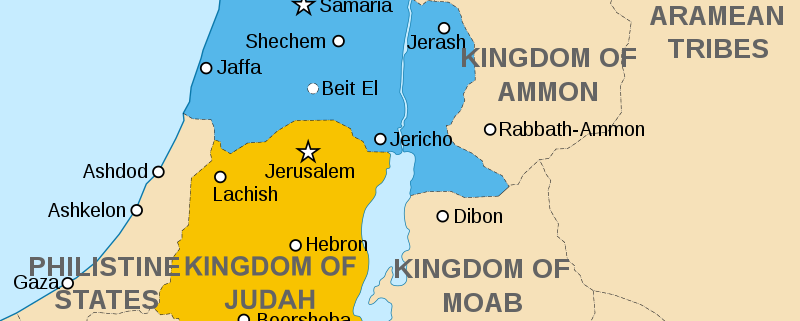The history of Ancient Israel and Judah in 6 minutes
I offer the following brief history of ancient Israel and Judah as a way to help students of Biblical history, especially young people. It takes 6 minutes to read through the following 1,000 words covering Israel’s 4,000 year old history! In an age of short attention spans, it may be a helpful tool for anyone, but especially parents to both understand and explain to others the history of ancient Israel and Judah. I didn’t add timelines and verse references on purpose. My goal was to create a smooth flowing narrative rather than a sophisticated study tool, if which there are many. George
The descendants of Abraham, to whom the land of Israel was promised, were a federation of twelve tribes in the era starting with Abraham and all the way to the era of the judges.
The judge was not a king but the twelve tribes followed him in times of conflict and war, which was often.
According to the book of genesis the Hebrews had been enslaved in Egypt before they invaded the Lavant where they completely destroyed several Canaanite city-states and their populations.
Such conquest was the only time in Israel’s history where offensive warfare would be used to seize other lands. The Bible clearly teaches that God used the Israelites for the conquest of the Promised Land as a way of executing a judgment on the peoples living there at the time. After the initial conquest they moved further north along the coast.
The period of judges lasted roughly from the fourteenth through eleventh centuries BC.
During these centuries at one time or another the Hebrew tribes would be vassals or tributaries of the Edomites, Moabites, Canaanites, Medianites, Ammonites, or Philistines.
The Philistines held a long time technological advantage over Israel in that they had iron weaponry and chariots.
In the north the Aramean kings of Damascus will be a long time foes as well. Their spoken and written language Aramaic would fuse into Hebrew around the sixth century BC in the Levant and by the first century it was the dominant spoken language throughout the Near East.
The people tired of being led by judges and wanted a permanent king. The last judge, Samuel, anointed Saul as the first king of the united kingdom of Israel.
David, a young man who initially was favored by Saul, fled after his popularity among the people soared resulting from defeating the philistine Goliath in a duel.
Ironically, he fled and lived among the Philistines working as a mercenary for the king of Gath, the city that Goliath came from.
Tragically, Saul would be killed in a battle against the Philistines.
David then returned with a motley band of international warriors known as his ‘mighty men’ and would first conquer the south. Conquering the previously independent Jebusite city of Jerusalem, he made it his capital. He then moved north and defeated Saul’s son Ishbosheth, who had ruled Israel for 2 years.
David spent much of his 40-year long reign waging war on many of the Canaanite city-states within and surrounding Israel’s borders.
His son Solomon succeeded him and was renowned for his wealth and wisdom.
Following Solomon’s death the ten northern tribes rebelled, establishing the city of Samaria as their capital city while Judah in the south remained loyal to Solomon’s son Rehoboam.
Israel and Judah would have hostile relations with each other from the beginning.
Jeroboam, king of Israel, had fled to Egypt during the reign of Solomon, receiving protection of the pharaoh Shoshenq.
The 10 northern tribes had become discontent with Solomon’s extravagance and welcomed Jeroboam as a liberator. Shoshenq saw opportunity and invaded Judah in the fifth yeah of Rehoboam’s reign.
With more than 60,000 men he subdued Judah making it a vassal state.
Finally, Egyptian influence was ended over Judah when an Egyptian backed Ethiopian army was defeated by King Asa of Judah.
The tumultuous relationship between the divided kingdoms would continue to unfold in a chaotic and blood splattered tale until the Syrian conquest of Israel ended that kingdom.
Josiah, Israel’s last king, stopped paying tribute to the Assyrian empire when he mistakenly believed that Egypt would back him up in the conflict. However, this was not the case and after 3-year siege Assyria conquered Samaria. The kingless vassal rebelled again and the Assyrians brutally crushed it. The survivors of the ten tribes were deported to distant areas of the Assyrian empire.
Their fate became unknown, giving way to many “Lost Tribes” theories and speculations, even to this day.
The last king of Judah, Zedekiah, was installed by the Babylonians as a puppet-king.
However, he did not play along and rebelled against the Babylonians at which point Nebuchadnezzar II laid siege and conquered Jerusalem, taking many captives back to Babylon.
Under the Persian empire Babylonian captives were allowed to return and enjoyed some level of autonomy as a vassal.
But in the second century BC, a group of Jews known as the Maccabeans led a revolt against the Seleucid empire (one of the empires that came into existence after Alexander the Great) and succeeded. This gave rise to the Hasmonean dynasty which ruled over the new Jewish state in the Levant.
In 69 BC the Roman general Pompey Magnus sacked Jerusalem and installed a puppet ruler loyal to him.
In 37 BC Judea would become an official client state of the Roman Empire.
The Idumaenian, Herod the Great was appointed king of the Jews by the Roman Senate. He attempted to curry favor with his subjects by reconstructing the temple in Jerusalem on a grand scale. However, this was funded through heavy taxation and he was still viewed as an unpopular foreigner and acolyte of the Romans.
After his death the kingdom was partitioned between his three sons and sister.
Following the death of his grandson, Herod Agrippa, in 44 AD Rome absorbed Judea into the empire and after a short rule by Agrippa’s son (Agrippa II) made it a full province of the Roman Empire administered by a Roman governor.
The period between 66-70 AD is known as the Great Jewish Revolt, or The Jewish War, which was followed by two more rebellions.
In 70 AD Jerusalem was sacked. The Romans destroyed the temple and either killed, exiled or enslaved all of the Hebrew leaders, elites and nobles.
In 132 AD the remaining Jews, under the leadership of Bar Kokhba, rebelled against the Roman Emperors Adrian but were defeated.
As a punishment Adrian exiled even more Jews and forbade them from living in their capital.
This marked the beginning of many centuries of Jewish exile which era ended with the creation of the modern, democratic State of Israel in 1947.





Leave a Reply
Want to join the discussion?Feel free to contribute!